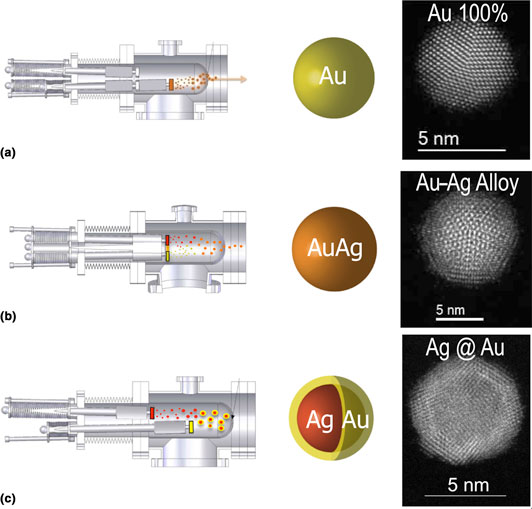Article contents
Gas-phase synthesis of nanoparticles: present status and perspectives
Published online by Cambridge University Press: 22 August 2018
Abstract

There is an increasing interest in the generation of well-defined nanoparticles (NPs) not only because of their size-related particular properties, but also because they are promising building blocks for more complex materials in nanotechnology.
Here, we will shortly introduce the gas-phase synthesis technology that has evolved rapidly in the last years and allows the fabrication of complex NPs with controllable and tuneable chemical composition and structure while keeping very good control over the size distribution. We will also address some limitations of the technology (stability over time, production yield, etc.) and discuss possible solutions.
Information
- Type
- Research Letters
- Information
- Copyright
- Copyright © Materials Research Society 2018
References
1.Frank, F., Schulze, W., Tesche, B., Urban, J., and Winter, B.: Formation of metal-clusters and molecules by means of the gas aggregation technique and characterization of size distribution. Surf. Sci. 156, 90–99 (1985).Google Scholar
2.Binns, C.: Handbook of Metal Physics, Volume 5: Metallic Nanoparticles (Elsevier, Hungary, 2008).Google Scholar
4.Haberland, H., Karrais, M., and Mall, M.: A new type of cluster and cluster ion-source. Z. Phys. D Atoms Mol. Clusters 20, 413–415 (1991).Google Scholar
5.Haberland, H., Karrais, M., Mall, M., and Thurner, Y.: Thin-films from energetic cluster impact – a feasibility study. J. Vac. Sci. Technol. A 10, 3266–3271 (1992).Google Scholar
6.Bai, J. and Wang, J.-P.: High-magnetic-moment core-shell-type FeCo-Au/Ag nanoparticles. Appl. Phys. Lett. 87, 152502 (2005).Google Scholar
7.Hennes, M., Lotnyk, A., and Mayr, S.G.: Plasma-assisted synthesis and high-resolution characterization of anisotropic elemental and bimetallic core-shell magnetic nanoparticles. Beilstein J. Nanotechnol. 5, 466–475 (2014).Google Scholar
8.Benelmekki, M., Bohra, M., Kim, J.-H., Diaz, R., Vernieres, J., Grammatikopoulos, P., and Sowwan, M.: A facile single-step synthesis of ternary multicore magneto-plasmonic nanoparticles. Nanoscale 6, 3532 (2014).Google Scholar
9.Johnson, G.E., Colby, R., and Laskin, J.: Soft landing of bare nanoparticles with controlled size, composition, and morphology. Nanoscale 7, 3491 (2015).Google Scholar
10.Martínez, L., Díaz, M., Román, E., Ruano, M., Llamosa P, D., and Huttel, Y.: Generation of nanoparticles with adjustable size and controlled stoichiometry: recent advances. Langmuir 28, 11241 (2012).Google Scholar
11.Llamosa, D., Ruano, M., Martínez, L., Mayoral, A., Roman, E., García-Hernández, M., and Huttel, Y.: The ultimate step towards a tailored engineering of core@shell and core@shell@shell nanoparticles. Nanoscale 6, 13483 (2014).Google Scholar
12.Mayoral, A., Llamosa, D., and Huttel, Y.: A novel Co@Au structure formed in bimetallic core@shell nanoparticles. Chem. Commun. 51, 8442 (2015).Google Scholar
13.Martínez, L., Mayoral, A., Espiñeira, M., Roman, E., Palomares, F.J., and Huttel, Y.: Core@shell, Au@TiOx nanoparticles by gas phase synthesis. Nanoscale 9, 6463 (2017).Google Scholar
14.Chen, B., ten Brink, G.H., Palasantzas, G., and Kooi, B.J.: Size-dependent and tunable crystallization of GeSbTe phase-change nanoparticles. Sci. Rep. 6, 39546 (2016).Google Scholar
15.Llamosa, D., Martínez, L., and Huttel, Y.: Multiple ion cluster source for the generation of magnetic nanoparticles: investigation of the efficiency as a function of the working parameters for the case of cobalt. Dataset Pap. Nanotechnol. 2014, 584391 (2014).Google Scholar
16.Ruano, M., Martínez, L., and Huttel, Y.: Investigation of the working parameters of a single magnetron of a multiple ion cluster source: determination of the relative influence of the parameters on the size and density of nanoparticles. Dataset Pap. Sci. 2013, 597023 (2013).Google Scholar
17.Martínez, L., Lauwaet, K., Santoro, G., Sobrado, J.M., Peláez, R.J., Herrero, V.J., Tanarro, I., Ellis, G.J., Cernicharo, J., Joblin, C., Huttel, Y., and Martín-Gago, J.A.: Precisely controlled fabrication, manipulation and in-situ analysis of Cu based nanoparticles. Sci. Rep. 8, 7250 (2018).Google Scholar
18.Panjan, M., Loquai, S., Klemberg-Sapieha, J.E., and Martinu, L.: Non-uniform plasma distribution in dc magnetron sputtering: origin, shape and structuring of spokes. Plasma Sources Sci. Technol. 24, 065010 (2015).Google Scholar
19.Ganeva, M., Pipa, A.V., and Hippler, R.: The influence of target erosion on the mass spectra of clusters formed in the planar DC magnetron sputtering source. Surf. Coat. Technol. 213, 41–47 (2012).Google Scholar
20.Rai, A., Mutzke, A., Bandelow, G., Schneider, R., Ganeva, M., Pipa, A.V., and Hippler, R.: Operational limit of a planar DC magnetron cluster source due to target erosion. Nucl. Instrum. Methods Phys. Res. B 316, 6–12 (2013).Google Scholar
21.De Bosscher, W. and Lievens, H.: Advances in magnetron sputter sources. Thin Solid Films 351, 15 (1999).Google Scholar
22.Marek, A., Valter, J., Kadlec, S., and Vyskočil, J.: Gas aggregation nanocluster source - Reactive sputter deposition of copper and titanium nanoclusters. Surf. Coat. Technol. 205, S573 (2011).Google Scholar
23.Peter, T., Polonskyi, O., Gojdka, B., Ahadi, A.M., Strunskus, T., Zaporojtchenko, V., Biederman, H., and Faupel, F.: Influence of reactive gas admixture on transition metal cluster nucleation in a gas aggregation cluster source. J. Appl. Phys. 112, 114321 (2012).Google Scholar
24.Polasek, J., Masek, K., Marek, A., and Vyskocil, J.: Effects of oxygen addition in reactive cluster beam deposition of tungsten by magnetron sputtering with gas aggregation. Thin Solid Films 591, 194 (2015).Google Scholar
25.Krishnan, G., de Graaf, S., ten Brink, G.H., Persson, P.O.Å., Kooi, B.J., and Palasantzas, G.: Strategies to initiate and control the nucleation behavior of bimetallic nanoparticles. Nanoscale 9, 8149–8156 (2017).Google Scholar
- 37
- Cited by


